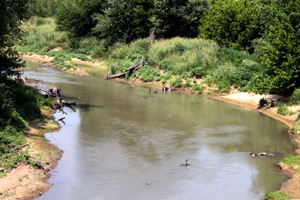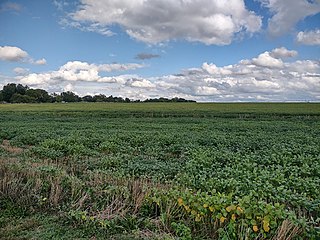
Mayes County is a county located in the U.S. state of Oklahoma. As of the 2020 census, the population was 39,046. Its county seat is Pryor Creek. Named for Samuel Houston Mayes, Principal Chief of the Cherokee Nation from 1895 to 1899, it was originally created at the Sequoyah Convention in August 1905.

The Battle of Pea Ridge, also known as the Battle of Elkhorn Tavern, took place during the American Civil War near Leetown, northeast of Fayetteville, Arkansas. Federal forces, led by Brig. Gen. Samuel R. Curtis, moved south from central Missouri, driving Confederate forces into northwestern Arkansas. Maj. Gen. Earl Van Dorn had launched a Confederate counteroffensive, hoping to recapture northern Arkansas and Missouri. Confederate forces met at Bentonville and became the most substantial Rebel force, by way of guns and men, to assemble in the Trans-Mississippi. Against the odds, Curtis held off the Confederate attack on the first day and drove Van Dorn's force off the battlefield on the second. By defeating the Confederates, the Union forces established Federal control of most of Missouri and northern Arkansas.

Brigadier-General Stand Watie, also known as Standhope Uwatie and Isaac S. Watie, was a Cherokee politician who served as the second principal chief of the Cherokee Nation from 1862 to 1866. The Cherokee Nation allied with the Confederate States during the American Civil War, and he was subsequently the only Native American Confederate general officer. Watie commanded Indian forces in the Trans-Mississippi Theater, made up mostly of Cherokee, Muskogee, and Seminole. He was the last Confederate States Army general to surrender.

The Battle of Mine Creek, also known as the Battle of Little Osage, was fought on October 25, 1864, in Linn County, Kansas, as part of Price's Missouri Campaign during the American Civil War. Major-General Sterling Price had begun an expedition in September 1864 to restore Confederate control of Missouri. After being defeated at Westport near Kansas City on October 23, Price's army began to retreat south through Kansas. Early on October 25, Price's army was defeated at the Marais des Cygnes. After Marais des Cygnes, the Confederates fell back, but were stalled at the crossing of Mine Creek while a wagon train attempted to cross.

The Battle of Marmiton River, also known as Shiloh Creek or Charlot's Farm, occurred on October 25, 1864, in Vernon County, Missouri during the American Civil War. Major General Sterling Price of the Confederate States Army commenced an expedition into Missouri in September 1864, with hopes of challenging Union control of the state. After a defeat at the Battle of Westport on October 23, Price began to retreat south, and suffered a serious defeat at the Battle of Mine Creek early on October 25. The afternoon of the 25th, Price's wagon train became stalled at the crossing of the Marmaton River in western Missouri. A delaying force led by Brigadier General Joseph O. Shelby attempted to hold off Union cavalry commanded by Brigadier General John McNeil and Lieutenant Colonel Frederick W. Benteen. Shelby was unable to drive off the Union force, although fatigue of the Union cavalry's horses prevented close-quarters action. At nightfall, the Confederates disengaged and destroyed much of their wagon train. Price was again defeated on October 28 at the Second Battle of Newtonia, and the Confederate retreat continued until the survivors reached Texas in early December.
The Battle of Chustenahlah was fought in Osage County, Oklahoma, on December 26, 1861, during the American Civil War. A band of 9,000 pro-Union Native Americans was forced to flee to Kansas in bitter cold and snow in what became known as the Trail of Blood on Ice.

The Battle of Chusto-Talasah, also known as Bird Creek, Caving Banks, and High Shoal, was fought December 9, 1861, in what is now Tulsa County, Oklahoma during the American Civil War. It was the second of three battles in the Trail of Blood on Ice campaign for the control of Indian Territory during the American Civil War.

Fort Gibson is a historic military site next to the modern city of Fort Gibson, in Muskogee County Oklahoma. It guarded the American frontier in Indian Territory from 1824 to 1888. When it was constructed, the fort was farther west than any other military post in the United States. It formed part of the north–south chain of forts that was intended to maintain peace on the frontier of the American West and to protect the southwestern border of the Louisiana Purchase. The fort succeeded in its peacekeeping mission for more than 50 years, as no massacres or battles occurred there.

The Battle of Honey Springs, also known as the Affair at Elk Creek, on July 17, 1863, was an American Civil War engagement and an important victory for Union forces in their efforts to gain control of the Indian Territory. It was the largest confrontation between Union and Confederate forces in the area that would eventually become Oklahoma. The engagement was also unique in the fact that white soldiers were the minority in both fighting forces. Native Americans made up a significant portion of each of the opposing armies and the Union force contained African-American units.
The trans-Mississippi theater of the American Civil War was the scene of the major military operations west of the Mississippi River. The area is often thought of as excluding the states and territories bordering the Pacific Ocean, which formed the Pacific coast theater of the American Civil War (1861–1865).
The Battle of Old Fort Wayne, also known as Maysville, Beattie's Prairie, or Beaty's Prairie, was an American Civil War battle on October 22, 1862, in Delaware County in what is now eastern Oklahoma.

The 1st Cherokee Mounted Rifles was a cavalry formation of the Confederate States Army in the Trans-Mississippi Theater of the American Civil War.

During the American Civil War, most of what is now the U.S. state of Oklahoma was designated as the Indian Territory. It served as an unorganized region that had been set aside specifically for Native American tribes and was occupied mostly by tribes which had been removed from their ancestral lands in the Southeastern United States following the Indian Removal Act of 1830. As part of the Trans-Mississippi Theater, the Indian Territory was the scene of numerous skirmishes and seven officially recognized battles involving both Native American units allied with the Confederate States of America and Native Americans loyal to the United States government, as well as other Union and Confederate troops.
Confederate monuments and memorials in the United States include public displays and symbols of the Confederate States of America (CSA), Confederate leaders, or Confederate soldiers of the American Civil War. Many monuments and memorials have been or will be removed under great controversy. Part of the commemoration of the American Civil War, these symbols include monuments and statues, flags, holidays and other observances, and the names of schools, roads, parks, bridges, buildings, counties, cities, lakes, dams, military bases, and other public structures. In a December 2018 special report, Smithsonian Magazine stated, "over the past ten years, taxpayers have directed at least $40 million to Confederate monuments—statues, homes, parks, museums, libraries, and cemeteries—and to Confederate heritage organizations."

The ambush of the steamboat J.R. Williams was a military engagement during the American Civil War. It took place on June 15, 1864, on the Arkansas River in the Choctaw Nation which became encompassed by the State of Oklahoma. It is popularly termed the "only naval battle" in that landlocked state. It was a successful Confederate attack on the Union Army's lines of supply. The Confederate forces were Cherokee, Choctaw, Chickasaw and Creek Indians led by General Stand Watie, who was a Cherokee.
The Second Battle of Cabin Creek was part of a plan conceived by Confederate Brigadier General Stand Watie, who had been promoted from colonel after the First Battle of Cabin Creek. The plan was to have a Confederate force attack central Kansas from Indian Territory, raiding Union Army facilities and encouraging Indian tribes in Western Kansas to join in an attack on the eastern part of the state. Watie presented the plan to his superior, General S. B. Maxey on February 5, 1864. Maxey approved the plan on the condition that the attack would start by October 1, to coincide with an attack on Missouri already planned by General Sterling Price.
The First Battle of Cabin Creek occurred from July 1 to July 2, 1863, Mayes County, Oklahoma during the American Civil War. Confederate forces, led by Colonel Stand Watie, sought to ambush a Union supply convoy commanded by Colonel James Monroe Williams. However, Williams received advance warning of the attack. Despite the swollen waters of the creek due to rain, Williams launched a successful assault on the entrenched Confederate position, forcing them to retreat. Although a Confederate Army detachment attempted to raid a Union Army supply train bound for Fort Gibson in July 1863, they were unable to impede the Union detachment, which contributed to the Union's victory in the Battle of Honey Springs later that month. Notably, this battle marked the first instance of African American troops fighting alongside their white comrades.

The Osage Battalion was a Native American unit of the Confederate States Army. Recruited from among the Osage tribe, whose loyalties were split between the Union and Confederacy, it did not meet its 500-man establishment. From early 1863 a four-company battalion of 200 men served under Brigadier General Douglas H. Cooper in the Trans-Mississippi Department. In 1864 the unit was transferred to the First Indian Brigade under Native American Brigadier General Stand Watie and fought under his command at the Second Battle of Cabin Creek on September 19, 1864. The battalion surrendered to Union forces on June 23, 1865, one of the last Confederate units to lay down its arms.

The Second Battle of Newtonia Site is a battlefield listed on the National Register of Historic Places (NRHP) near Newtonia and Stark City in Missouri. In late 1864, Major General Sterling Price of the Confederate States Army began a raid into Missouri in hopes of diverting Union troops away from more important theaters of the American Civil War. After a defeat at the Battle of Westport on October 23, Price's Army of Missouri began retreating through Kansas, but suffered three consecutive defeats on October 25. By October 28, the retreating Confederates had reached Newtonia, where the Second Battle of Newtonia broke out when Union pursuers caught up with the Confederates. Confederate cavalry under Brigadier General Joseph O. Shelby was initially successful, but after Union reinforcements under Brigadier General John B. Sanborn counterattacked, the Confederates withdrew. The Union troops did not pursue, and Price's men escaped, eventually reaching Texas by December.
The Mansfield State Historic Site, also known as the Mansfield Battlefield, is a battlefield in DeSoto Parish, Louisiana. The Louisiana state historic site commemorates the Battle of Mansfield fought on Friday, April 8, 1864, during the Red River Campaign of the American Civil War. The site was listed in the U.S. National Register of Historic Places as the Mansfield Battle Park in 1973. Established in 1924 by the United Daughters of the Confederacy, the site was transferred to the state of Louisiana in 1954.













